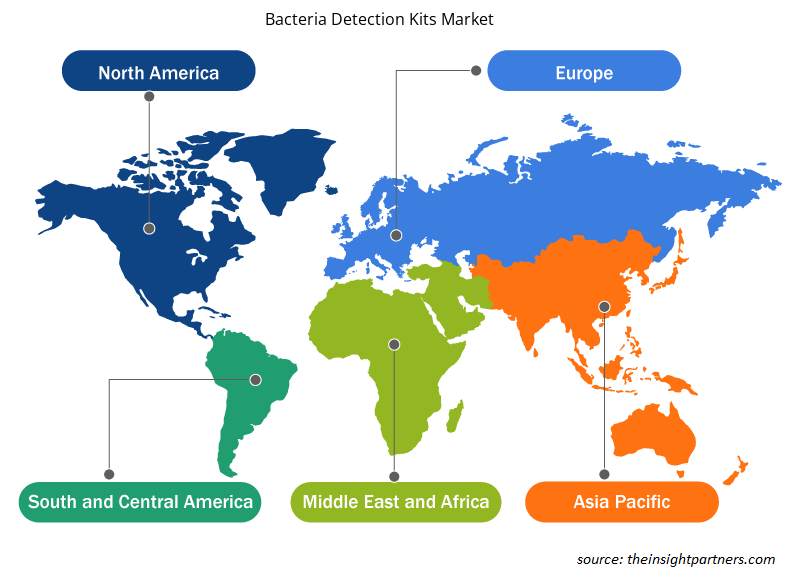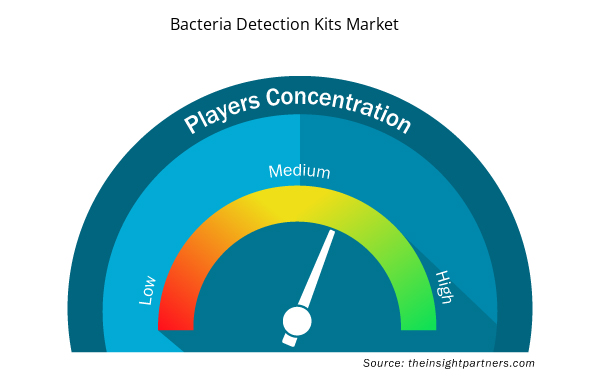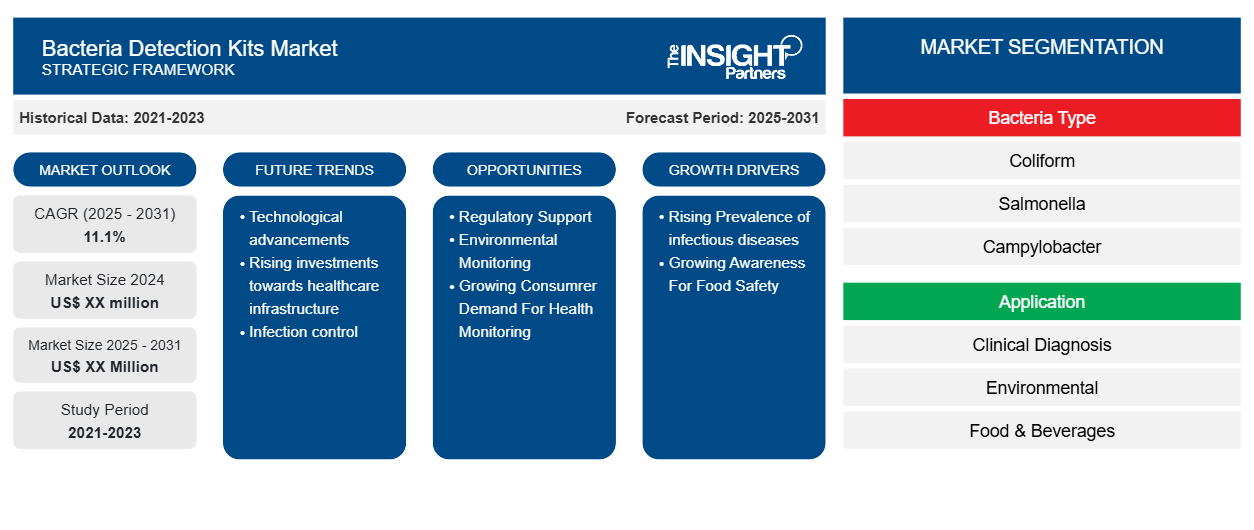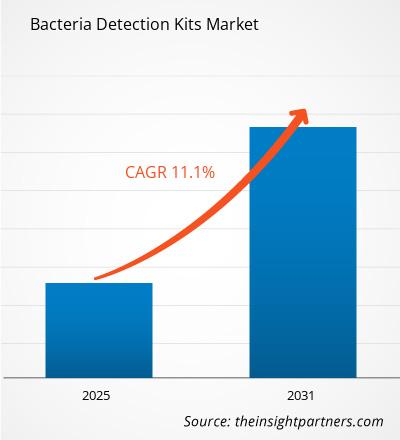Si prevede che il mercato dei kit per il rilevamento dei batteri registrerà un CAGR dell'11,1% dal 2023 al 2031, con una dimensione di mercato in espansione da XX milioni di dollari nel 2023 a XX milioni di dollari entro il 2031.
Il rapporto è segmentato in base a Bacteria Detection Kits Market By Bacteria Type (Coliformi, Salmonella, Campylobacter, Legionella, Listeria e altri), Applicazione (Diagnosi clinica, Ambientale e Alimenti e bevande), Utente finale (Ospedali e cliniche, Centri diagnostici e Industriale) e Geografia (Nord America, Europa, Asia Pacifico, Medio Oriente e Africa e Sud e Centro America). L'analisi globale è ulteriormente suddivisa a livello regionale e nei principali paesi. Il rapporto offre il valore in USD per l'analisi e i segmenti di cui sopra.
Scopo del rapporto
Il report Bacteria Detection Kits Market di The Insight Partners mira a descrivere il panorama attuale e la crescita futura, i principali fattori trainanti, le sfide e le opportunità. Ciò fornirà spunti a vari stakeholder aziendali, come:
- Fornitori/produttori di tecnologia: per comprendere le dinamiche di mercato in evoluzione e conoscere le potenziali opportunità di crescita, consentendo loro di prendere decisioni strategiche informate.
- Investitori: condurre un'analisi completa delle tendenze in merito al tasso di crescita del mercato, alle proiezioni finanziarie del mercato e alle opportunità esistenti lungo la catena del valore.
- Enti di regolamentazione: regolamentano le politiche e le attività di controllo sul mercato allo scopo di ridurre al minimo gli abusi, preservare la fiducia degli investitori e sostenere l'integrità e la stabilità del mercato.
Segmentazione del mercato dei kit di rilevamento dei batteri
Tipo di batteri
- Coliform
- Salmonella
- Campilobatterio
- Legionella
- Listeria
- Altri
Applicazione
- Diagnosi clinica
- Ambientale
- Cibo e bevande
Utente finale
- Ospedali e cliniche
- Centri Diagnostici
- Industriale
Geografia
- America del Nord
- Europa
- Asia-Pacifico
- America del Sud e Centro
- Medio Oriente e Africa
Geografia
- America del Nord
- Europa
- Asia-Pacifico
- America del Sud e Centro
- Medio Oriente e Africa
Personalizza questo report in base alle tue esigenze
Riceverai la personalizzazione gratuita di qualsiasi report, comprese parti di questo report, o analisi a livello nazionale, pacchetto dati Excel, oltre a usufruire di grandi offerte e sconti per start-up e università
- Scopri le principali tendenze di mercato in questo rapporto.Questo campione GRATUITO includerà analisi di dati che spaziano dalle tendenze di mercato alle stime e alle previsioni.
Driver di crescita del mercato dei kit di rilevamento dei batteri
- Prevalenza crescente di malattie infettive: ciò ha reso urgente la necessità di sviluppare mezzi diagnostici rapidi e accurati in modo che sia possibile avviare un intervento tempestivo nei malati di queste malattie. Come informato dai rapporti dell'Organizzazione Mondiale della Sanità, il carico globale di malattie infettive sta aumentando a un ritmo costante e c'è una domanda sempre crescente di kit efficaci per la rilevazione dei batteri per facilitare la diagnosi precoce e il trattamento.
- Crescente consapevolezza per la sicurezza alimentare: una maggiore consapevolezza tra i consumatori sulle malattie trasmesse dagli alimenti e la necessità di sicurezza alimentare ha aumentato la domanda di kit di rilevamento dei batteri nell'industria alimentare. Inoltre, le agenzie di regolamentazione impongono test ancora più severi sui prodotti alimentari per i patogeni attraverso la richiesta di test severi, il che a sua volta aumenta l'adozione di strumenti diagnostici.
- Espansione delle tecnologie POC - La tendenza è stata tale che i test point-of-care consentono risultati immediati in varie cliniche e, in effetti, in luoghi remoti. Questa tendenza si verifica in particolare durante le epidemie o anche in luoghi con strutture di laboratorio limitate, il che implica che i kit portatili per il rilevamento dei batteri sono molto importanti.
Kit di rilevamento dei batteri Tendenze future del mercato
- Progressi tecnologici: altre innovazioni nella diagnostica molecolare includono la tecnologia PCR e il sequenziamento di nuova generazione, migliorando la velocità e l'accuratezza del rilevamento batterico, quindi progressi che facilitano i laboratori nell'identificare rapidamente i patogeni, quindi una facilitazione dell'efficacia nel processo diagnostico. Tali fattori tecnologici aiuteranno la crescita del mercato negli anni a venire
- Aumento degli investimenti verso le infrastrutture sanitarie: il governo e i settori privati stanno investendo molto nelle infrastrutture sanitarie, soprattutto nei paesi in via di sviluppo. Ad esempio, i loro investimenti vanno ad aggiornare le competenze di laboratorio e a facilitare l'accesso agli strumenti diagnostici, aumentando così la domanda di kit di rilevamento dei batteri.
- Controllo delle infezioni: ospedali e istituzioni sanitarie hanno dedicato molta attenzione alle misure di controllo delle infezioni nel tentativo di prevenire le infezioni contratte in ospedale. La contaminazione microbica in queste configurazioni è quindi fondamentale da monitorare e controllare, un motivo che rende cruciale l'adozione dei kit da parte degli operatori sanitari.
Opportunità di mercato per i kit di rilevamento dei batteri
- Supporto normativo: le rigide normative relative agli standard di igiene e sicurezza nei settori sanitario e alimentare stanno costringendo le organizzazioni ad adottare metodi affidabili di rilevamento dei batteri. Poiché le implementazioni di sistemi diagnostici avanzati spesso derivano dalla conformità a tali normative, la crescita del mercato è generalmente guidata da questo fine
- Monitoraggio ambientale: a causa dell'inquinamento e della sicurezza dell'acqua, c'è una crescente preoccupazione per il monitoraggio ambientale; quindi, sorge la necessità di kit di rilevamento dei batteri. Per determinare la presenza di contaminazione microbica in acqua, suolo e aria, questi kit di rilevamento diventano importanti, aumentando così le loro applicazioni oltre il loro contesto precedente nell'impostazione sanitaria.
- Crescente domanda dei consumatori per il monitoraggio della salute: negli ultimi anni, l'importanza del monitoraggio della salute personale è cresciuta nella mente dei consumatori. Attualmente, con il crescente interesse per le soluzioni di test a domicilio, che saranno in grado di rilevare i batteri, si sta lavorando allo sviluppo di kit abbastanza intuitivi da poter essere utilizzati anche da non professionisti.
Approfondimenti regionali sul mercato dei kit di rilevamento dei batteri
Le tendenze regionali e i fattori che influenzano il mercato dei kit di rilevamento batterico durante il periodo di previsione sono stati ampiamente spiegati dagli analisti di Insight Partners. Questa sezione discute anche i segmenti e la geografia del mercato dei kit di rilevamento batterico in Nord America, Europa, Asia Pacifico, Medio Oriente e Africa e Sud e Centro America.

- Ottieni i dati specifici regionali per il mercato dei kit di rilevamento dei batteri
Ambito del rapporto di mercato sui kit di rilevamento dei batteri
| Attributo del report | Dettagli |
|---|---|
| Dimensioni del mercato nel 2023 | XX milioni di dollari USA |
| Dimensioni del mercato entro il 2031 | XX milioni di dollari USA |
| CAGR globale (2023-2031) | 11,1% |
| Dati storici | 2021-2022 |
| Periodo di previsione | 2024-2031 |
| Segmenti coperti | Per tipo di batterio
|
| Regioni e Paesi coperti | America del Nord
|
| Leader di mercato e profili aziendali chiave |
|
Kit di rilevamento batterico Attori del mercato Densità: comprendere il suo impatto sulle dinamiche aziendali
Il mercato dei kit di rilevamento dei batteri sta crescendo rapidamente, spinto dalla crescente domanda degli utenti finali dovuta a fattori quali l'evoluzione delle preferenze dei consumatori, i progressi tecnologici e una maggiore consapevolezza dei benefici del prodotto. Con l'aumento della domanda, le aziende stanno ampliando le loro offerte, innovando per soddisfare le esigenze dei consumatori e capitalizzando sulle tendenze emergenti, il che alimenta ulteriormente la crescita del mercato.
La densità degli operatori di mercato si riferisce alla distribuzione di aziende o società che operano in un particolare mercato o settore. Indica quanti concorrenti (operatori di mercato) sono presenti in un dato spazio di mercato in relazione alle sue dimensioni o al valore di mercato totale.
Le principali aziende che operano nel mercato dei kit di rilevamento dei batteri sono:
- Minerva Biolabs GmbH
- PromoCell GmbH
- Diagnostica creativa
- Sartorius AG
- Scienze del fascino
Disclaimer : le aziende elencate sopra non sono classificate secondo un ordine particolare.

- Ottieni la panoramica dei principali attori del mercato dei kit di rilevamento dei batteri
Punti di forza chiave
- Copertura completa: il rapporto copre in modo completo l'analisi di prodotti, servizi, tipologie e utenti finali del mercato dei kit di rilevamento dei batteri, fornendo una panoramica olistica.
- Analisi degli esperti: il rapporto è compilato sulla base della conoscenza approfondita di esperti e analisti del settore.
- Informazioni aggiornate: il rapporto garantisce la pertinenza aziendale grazie alla copertura di informazioni recenti e tendenze nei dati.
- Opzioni di personalizzazione: questo report può essere personalizzato per soddisfare le esigenze specifiche del cliente e adattarsi in modo appropriato alle strategie aziendali.
Il rapporto di ricerca sul mercato dei kit di rilevamento batterico può, quindi, aiutare a guidare il percorso di decodifica e comprensione dello scenario del settore e delle prospettive di crescita. Sebbene possano esserci alcune preoccupazioni valide, i vantaggi complessivi di questo rapporto tendono a superare gli svantaggi.
- Analisi storica (2 anni), anno base, previsione (7 anni) con CAGR
- Analisi PEST e SWOT
- Valore/volume delle dimensioni del mercato - Globale, regionale, nazionale
- Industria e panorama competitivo
- Set di dati Excel



Report Coverage
Revenue forecast, Company Analysis, Industry landscape, Growth factors, and Trends

Segment Covered
This text is related
to segments covered.

Regional Scope
North America, Europe, Asia Pacific, Middle East & Africa, South & Central America

Country Scope
This text is related
to country scope.
Domande frequenti
Hospitals & Clinics segment accounted for the largest share in 2023 and is expected to retain its dominance during the forecast period
In Europe, the UK held the second largest share in 2023.
Rising regulatory approvals
North America held the largest share in 2023 and is expected to retain its dominance during the forecast period
Rising Prevalence of infectious diseases
The Bacteria Detection Kits Market is estimated to witness a CAGR of 11.1% from 2023 to 2031
Trends and growth analysis reports related to Life Sciences : READ MORE..
1. Minerva Biolabs GmbH
2. PromoCell GmbH
3. Creative Diagnostics
4. Sartorius AG
5. Charm Sciences
6. Abnova Corporation
7. BioVisible
8. Genetic Signatures
9. ECHA MICROBIOLOGY LTD
10. NEMIS Technologies AG
The Insight Partners performs research in 4 major stages: Data Collection & Secondary Research, Primary Research, Data Analysis and Data Triangulation & Final Review.
- Data Collection and Secondary Research:
As a market research and consulting firm operating from a decade, we have published and advised several client across the globe. First step for any study will start with an assessment of currently available data and insights from existing reports. Further, historical and current market information is collected from Investor Presentations, Annual Reports, SEC Filings, etc., and other information related to company’s performance and market positioning are gathered from Paid Databases (Factiva, Hoovers, and Reuters) and various other publications available in public domain.
Several associations trade associates, technical forums, institutes, societies and organization are accessed to gain technical as well as market related insights through their publications such as research papers, blogs and press releases related to the studies are referred to get cues about the market. Further, white papers, journals, magazines, and other news articles published in last 3 years are scrutinized and analyzed to understand the current market trends.
- Primary Research:
The primarily interview analysis comprise of data obtained from industry participants interview and answers to survey questions gathered by in-house primary team.
For primary research, interviews are conducted with industry experts/CEOs/Marketing Managers/VPs/Subject Matter Experts from both demand and supply side to get a 360-degree view of the market. The primary team conducts several interviews based on the complexity of the markets to understand the various market trends and dynamics which makes research more credible and precise.
A typical research interview fulfils the following functions:
- Provides first-hand information on the market size, market trends, growth trends, competitive landscape, and outlook
- Validates and strengthens in-house secondary research findings
- Develops the analysis team’s expertise and market understanding
Primary research involves email interactions and telephone interviews for each market, category, segment, and sub-segment across geographies. The participants who typically take part in such a process include, but are not limited to:
- Industry participants: VPs, business development managers, market intelligence managers and national sales managers
- Outside experts: Valuation experts, research analysts and key opinion leaders specializing in the electronics and semiconductor industry.
Below is the breakup of our primary respondents by company, designation, and region:

Once we receive the confirmation from primary research sources or primary respondents, we finalize the base year market estimation and forecast the data as per the macroeconomic and microeconomic factors assessed during data collection.
- Data Analysis:
Once data is validated through both secondary as well as primary respondents, we finalize the market estimations by hypothesis formulation and factor analysis at regional and country level.
- Macro-Economic Factor Analysis:
We analyse macroeconomic indicators such the gross domestic product (GDP), increase in the demand for goods and services across industries, technological advancement, regional economic growth, governmental policies, the influence of COVID-19, PEST analysis, and other aspects. This analysis aids in setting benchmarks for various nations/regions and approximating market splits. Additionally, the general trend of the aforementioned components aid in determining the market's development possibilities.
- Country Level Data:
Various factors that are especially aligned to the country are taken into account to determine the market size for a certain area and country, including the presence of vendors, such as headquarters and offices, the country's GDP, demand patterns, and industry growth. To comprehend the market dynamics for the nation, a number of growth variables, inhibitors, application areas, and current market trends are researched. The aforementioned elements aid in determining the country's overall market's growth potential.
- Company Profile:
The “Table of Contents” is formulated by listing and analyzing more than 25 - 30 companies operating in the market ecosystem across geographies. However, we profile only 10 companies as a standard practice in our syndicate reports. These 10 companies comprise leading, emerging, and regional players. Nonetheless, our analysis is not restricted to the 10 listed companies, we also analyze other companies present in the market to develop a holistic view and understand the prevailing trends. The “Company Profiles” section in the report covers key facts, business description, products & services, financial information, SWOT analysis, and key developments. The financial information presented is extracted from the annual reports and official documents of the publicly listed companies. Upon collecting the information for the sections of respective companies, we verify them via various primary sources and then compile the data in respective company profiles. The company level information helps us in deriving the base number as well as in forecasting the market size.
- Developing Base Number:
Aggregation of sales statistics (2020-2022) and macro-economic factor, and other secondary and primary research insights are utilized to arrive at base number and related market shares for 2022. The data gaps are identified in this step and relevant market data is analyzed, collected from paid primary interviews or databases. On finalizing the base year market size, forecasts are developed on the basis of macro-economic, industry and market growth factors and company level analysis.
- Data Triangulation and Final Review:
The market findings and base year market size calculations are validated from supply as well as demand side. Demand side validations are based on macro-economic factor analysis and benchmarks for respective regions and countries. In case of supply side validations, revenues of major companies are estimated (in case not available) based on industry benchmark, approximate number of employees, product portfolio, and primary interviews revenues are gathered. Further revenue from target product/service segment is assessed to avoid overshooting of market statistics. In case of heavy deviations between supply and demand side values, all thes steps are repeated to achieve synchronization.
We follow an iterative model, wherein we share our research findings with Subject Matter Experts (SME’s) and Key Opinion Leaders (KOLs) until consensus view of the market is not formulated – this model negates any drastic deviation in the opinions of experts. Only validated and universally acceptable research findings are quoted in our reports.
We have important check points that we use to validate our research findings – which we call – data triangulation, where we validate the information, we generate from secondary sources with primary interviews and then we re-validate with our internal data bases and Subject matter experts. This comprehensive model enables us to deliver high quality, reliable data in shortest possible time.


 Ottieni un campione gratuito per questo repot
Ottieni un campione gratuito per questo repot